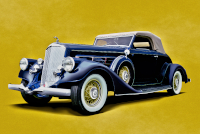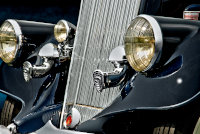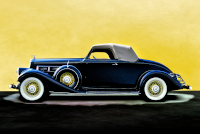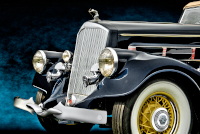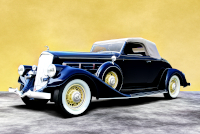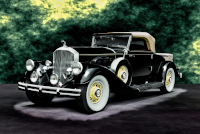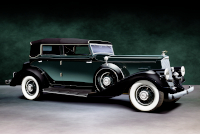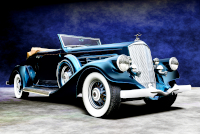Location:
Radnor Hunt Concours d'Elegance, 2011
Owner: Will Ayd | Glen Arm, Maryland
Prologue:
Owned at the time of photography by Morton Y. Bullock of Ruxton, Maryland, this car later past to Mr. Ayd, whence appearing at later concours under his ownership.
Welcome to 1935 at Pierce-Arrow... For starters, this Model 845 rolled around my stomping ground since new, first purchased in Baltimore and never leaving the region. At some point in my considerable time in Charm City, (a native myself), I might have located the original Pierce-Arrow dealership, though at present I cannot recall where. Kilduffs reports that the Foss-Hughes Company sold Pierce-Arrow trucks from 1315 Cathedral Street, across from the Baltimore & Ohio Mount Royal Station, part of the same neighborhood I called home for almost two decades. (A few blocks south sits the beautiful 1001 Cathedral Street, which was the Peerless showroom, known to locals of my generation as the City Cafe.) But new Pierce-Arrow cars more likely showed nearby along Mount Royal Avenue, the auto dealer hub.
In any case, this car pairs the 1934 Model 840A Convertible Sedan by LeBaron for its local roots, well known in the Baltimore region. And we've since captured a 1935 Model 1245 of the same style, whose profile I developed concurrently with this Model 845. Only a short visual survey, we can compare the 845 with the 1245 and wax about the lost world of our old city neighborhoods.
- - - - - - - - - -
► Image Source: Nikon D200 (10.2 MP) | Image Source 2 and 4 by E, illustrated by the author
References:
- Ralston, Marc. "Pierce-Arrow" A.S. Barnes & Co., Inc., San Diego, CA. 1980, page 180, 194, 232
- Automobile Quarterly, Volume 28, Number 4, Fourth Quarter 1990, "The Last Years of Luxury" by John C. Meyer III, The Kutztown Publishing Company, Inc., Kutztown, PA, page 95, 98
- Automobile Quarterly, Volume 6, Number 3, Third Quarter 1968, "Pierce-Arrow: An American Aristocrat," by Maurice D. Hendry, The Kutztown Publishing Company, Inc., Kutztown, PA, page 263
- Kilduffs: A treasure, always a go-to source for the esoterica of lost Baltimore.
Neither Automobile Quartly nor Marc Ralston say very much about the 1935 model year; it is the last significant sales slump, the one Pierce-Arrow will not recover from. In the midst of the turmoil, Pierce-Arrow models largely repeat from 1934, which leads to a dearth of excitement. Except that, for a year that cut its already anemic production in half, 1935 Pierce-Arrow cars are comparatively rare, particularly among special-bodied models.
The Convertible Coupe Roadster repeats itself from 1934 without mechanical changes, though 1935 is the final year of the Stewart-Warner power brake system. In 1936, Pierce-Arrow will find the energy to re-style the cars and make mechanical adjustment, which includes a return to hydraulic braking.
Good reason for the momentary hault on Pierce-Arrow evolution isn't simply financial crises, but the departure of two key leaders. In 1935, Vice President Roy Faulkner leaves for Duesenberg, an understandable move as brankruptcy reorganization has rendered his sales network impotent, ordering its dissolution and restricting production. A noted sales guru in the American motor industry, Faulkner has no tools to move Pierce-Arrow product.
Also in 1935, Chief Engineer Karl Wise leaves for Bendix, the parts manufacturer who supplied Pierce-Arrow its Startix automatic ignition system. Wise joined Pierce-Arrow in 1928 via the E-M-F Company, which existed for a glimmer of history, before joining Studebaker, itself a rather antediluvian vehicle manufacturer. (By this term, I mean Studebaker produced carriages well before the automobile's advent.) And of course Studebaker formed close ties with Pierce-Arrow in the classic era, facilitating Wise's transition. Karl Wise became for the classic era Pierce-Arrow what David Fergusson had been for the brass era Pierce-Arrow, the chief engineer who ensured the car met the highest standards for mechanical durability and daily performance.
Without its business and technical leads, Pierce-Arrow pauses in 1935, creating a run of cars that is both grand and rare, at least by the numbers. This Convertible Coupe Roadster among those numbers, the car is a lifelong Marylander and rare example of the 1935 rumble-seat roadster.
Motor: 6,309 cc (385 cubic inches) inline 8-cylinder, cast-iron block | 88.9 mm x 127 mm (3½" x 5") | #305467
Valvetrain: L-head, 2 valves per cylinder, with self-adjusting hydraulic tappets
Power: 140 hp @ 3,400 rpm
Drivetrain: 3-speed synchromesh gearbox, rear-wheel drive
Architecture: steel ladder frame chassis with steel body over wood frame
Wheelbase: 3,530.6 mm (139 inches)
Etymology:
In 1935, the three Pierce-Arrow models adopt a '-5' nomenclature, the first two moving from the Model 840A to the Model 845 (the straight-8), and from the Model 1240A to the Model 1245 (the Karl Wise V-12). Of course the already improperly named 1934 Model 1248A (V-12 on the long-chassis 147-inch wheelbase) becomes the Model 1255. But the formula is the same for all—add '-5' to the end for 1935.
The Convertible Coupe Roadster body style dates back to 1929, Pierce-Arrow's rather late shift into classic era motoring, the concept updating small-scale roadster exercises on the Model 80/81 platform as a proper luxury cabriolet. In this sense, 'convertible coupe' is adequate, whereas sales material used the roadster terminology and added "with rumble seat" just to be thorough. Pierce-Arrow gilded its model names, updating numbering systems year over year for the sake of novelty, preferring long-winded titles in lieu of pedestrian description.
Figures:
Ralston notes that Pierce-Arrow produced 875 total cars in 1935, roughly half of its 1934 production. There appear to be a handful of Convertible Coupe Roadsters from 1934 and 1935, both straight-8 and V-12 examples, which I know is not a helpful comment, but there remains no record of production according to body style from these latter years.
1935 Update: Minor Pierce-Arrow Styling Changes from 1934 to 1935
Outside, Pierce-Arrow replace the offset three-vent arrangement (three separate vents in a triangular pattern) with a single strip of three vents set within a chrome frame. The frame includes four sections speedlines separating each vent, which, in the case of this car, wear fine red paint. These accents appear non-standard for either the Model 845 or 1245. The vent update on the bonnet sides is the clear identifying feature of a 1935 Pierce-Arrow, though more subtle, the headlamp lenses are more convex than those preceding. Ralston opined that Pierce-Arrow were "losing the classic look" as of 1934, and these concical lenses are a small step further in that modern direction. Convex lenses make the Dawley-designed integrated headlamp a bit tubular, which fits ongoing streamlining trends. In this sense, a simple parts swap tweaks the Pierce-Arrow image.
1245 Comparison: Examining the Model 845 and Model 1245 Convertible Coupe Roadsters
We're fortunate to look at both the straight-8 and V-12 roadsters from 1935. The cars ride on identical 139-in wheelbase chassis and use identical bodies. By 1935, Pierce-Arrow pruned the entire catalogue to nine styles among all models, (excepting custom orders), a measure to kerb production costs in the face of bankruptcy. Subtle differences emerge only in optioning, where out Model 845 wears painted wire wheels, whereas our 1245 wears the Budd cast-steel artillery wheel. Both retain steel spare wheel covers, (noted by Pierce-Arrow society members as difficult to find as original parts), and both use the same light and horn arrangement. By 1936, Pierce-Arrow will dispense with the attached driving lights and develop an integrated quad-light arrangement, far less classic than Ralston would like but a modern evolution that foreshadowes the smooth lines of the late 1940s.
Shapely Profile: Modern Hints within the Streamlined Model 1245 Body
Particularly with its hood up and rumble seat stowed, we see a slight tail-end hunch that predicts the 1936 Lincoln Zephyr. These are the hefty shapes of Hudson and Willys that will soon drip over the rear wheels, which is an unexpected direction for Pierce-Arrow. But then the Convertible Coupe Roadster is a rare pleasure-craft among sedans and limousines and town cars. In this respect, the roadster either misses its target demographic, or simply arrives too soon.
Interior Update: Dash Panel Changes for 1935
What we cannot see in either profile at the moment, with my apologies, is the updated gauge cluster, which is the third notable design update for 1935. The update moves the main gauges toward the drive, either side of the steering column, which defines for the cabin that same departure from classic motoring to modern motoring.
Last Updated: Mar 26, 2025

